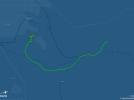Qantas B763 at Sydney on Nov 8th 2013, severe turbulence injures three passengers
The Australian TSB released their final report without a conclusion however releasing following safety message to passengers and crew:
Turbulence is a weather phenomenon responsible for the abrupt sideways and vertical jolts that passengers often experience during flights, and is the leading cause of in-flight injuries to passengers and cabin crew.
This incident serves as a timely reminder to passengers to safely stow any carry-on baggage, laptops, iPads and other items in the overhead locker or under the seat in front of you, particularly when the seatbelt light is turned ON. These items can become projectiles during turbulence if not properly secured.
The ATSB reported that the crew illuminated the "fasten seatbelt" signs when the aircraft descended through 10,000 feet on approach to Sydney. Later, when the aircraft descended through 4,200 feet on approach to runway 16L the aircraft encountered turbulence for about two minutes prompting the crew to abort the approach at about 3000 feet. While the aircraft climbed through 4200 feet the aircraft encountered severe turbulence, which made it hard to maintain control of the aircraft. The crew reported they needed full go around power to maintain altitude and speed. In the cabin a passenger was hit on his head by a laptop computer, that fell out of an overhead locker and caused a serious head injury, another passenger received a minor rib injury and a third passenger a minor injury from an iPad.
The aircraft continued to climb to 8000 feet and encountered turbulence for several minutes during the climb. The aircraft entered a hold for about 20 minutes, then ATC advised that a number of aircraft had successfully landed at Sydney. The crew commenced an approach to runway 16R but again aborted the approach at about 5000 feet due to turbulence and entered a hold. After about 40 minutes in that hold the crew declared PAN and decided to divert to Williamstown, where the aircraft landed safely and with the required minimum fuel remaining on board.
The ATSB reported that according to Met office a strong and gusty south-westerly change approached Sydney and produced windshear between 4000 and 5000 feet with up to 60 knots wind speed changes, a loss of 60 knots being encountered on descent towards Sydney.
http://avherald.com/h?article=46b376ea/0000














Komentarze